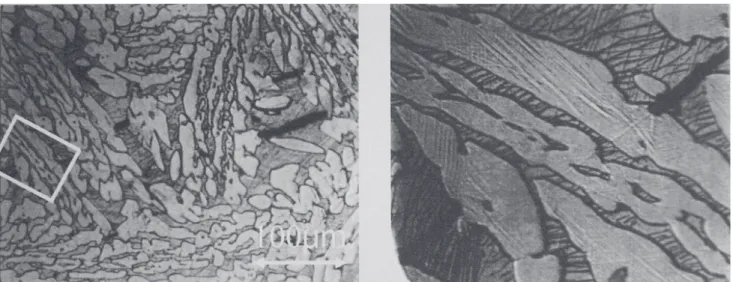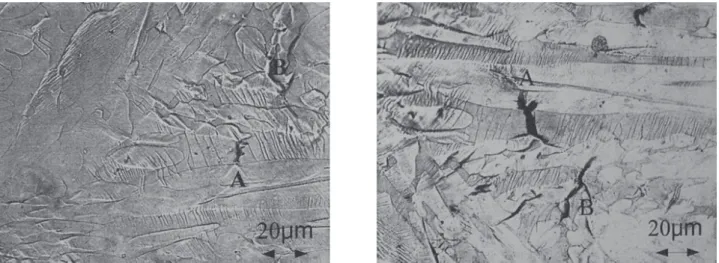Quantification of Damage Progression in a Thermally
Aged Duplex Stainless Steel
A. Hazarabediana*, and B. Marini b a DM / CAC / CNEA
Av. del Libertador 8250. Buenos Aires. (1430) Argentine b Commisariat à l’Énergie Atomique, DEN/DMN/SRMA,
Gif-sur-Yvette, 91191 France
Received: August 17, 2001; Revised: April 29, 2002
Ferrite of austeno-ferritic stainless steels maintained for a long time at temperatures in the range of 270 °C to 400 °C is embrittled like the known 475 °C embrittlement of ferritic stainless steels. Deformation and damage micromechanisms of a material must be known in order to apply the “local approach to fracture” (LAF) methodology. In this work we test a previous model of damage nucleation and evolution, extending its validity to low temperature - long term aging. We have determined cracking damage evolution by taking replicas of planar tensile specimens during uniaxial traction tests. Voronoï (Dirichlet) tessellation quantitative metallography was applied to characterize and quantify non-uniform damaging. Clustering criteria allowed the determination of the size, density and internal damaging rate of damage clusters.
Keywords: duplex austeno-ferritic stainless steel, thermal aging, metallography, Voronoï
1. Introduction
Corrosion resistant stainless steels (ASTM CF3, CF8 and CF8M) are widely used in cast components of the pri-mary circuit of nuclear power plants. These steels have a duplex ferrite - austenite microstructure. After a long time operation, (greater than 10000 h) at hot branch tempera-tures (approx. 325 °C) or cold branch temperatempera-tures (280 °C), these materials suffer an aging phenomenon1, similar to the 475 °C embrittlement of ferritic stainless steels2. Aging hard-ens the ferrite, and consequently the overall hardness and strength increase. However ductility, toughness and impact resistance decrease, ductile-brittle transition shifts to higher temperatures and the upper shelf energy lowers. To assess a component’s remaining life, it is necessary to determine the amount of the degradation of the mechanical properties, frac-ture toughness in particular. The thermal aging of cast du-plex stainless steels depends on many factors. The most re-ported are the ferrite content, thermal history, microstruc-ture, chemical composition and texture. Experimental re-sults present a wide scatter that difficults the task of pre-dicting a component state from a laboratory study. To deal with this problem, methods based on the local approach to fracture3 have been implemented. This approach , requires
the quantitative knowledge of the damage nucleation rate. Damage and fracture mechanisms of aged duplex stain-less steels are known and well documented in the litera-ture4. Ferrite is hardened as a consequence of the precipita-tion of ordered Cr rich phases or by spinodal decomposi-tion. Hardening promotes strain localization and the pre-mature cracking of ferrite islands. This cracks eventually became cavities that lead to the final ductile fracture by cav-ity growth and coalescence. Joly3 showed that this damage is not uniformly distributed. Some regions are more prone to fracture. These regions have the size of the ferritic packet (in the order of 0.5 mm3) and belong to regions where crystallographic orientation favors the cracking process. In particular, packets oriented in such a way that only one slip system is activated are much more damaged than the rest. The size, distribution, and damage rate inside these regions control the overall ductility.
Because final fracture is ductile, the material is described using an elastoplastic porous model, (Gurson – Tvergaard5). The yield stress in this model is given by:
( )
( )
( )
( )
−
=
y
y f q
σ ε σ ε
ε σ ε σ
p eq m 1
p eq p
eq 2 p eq 2 eq
2 3 cosh 2
1 (1)
*e-mail: hazarabe@cnea.gov.ar
where f is the volume fraction of porosity, q1 is a con-stant equal to 1,5, σm , σy and σeq are the hydrostatic, yield and equivalent stresses respectively and εp
eq is the equiva-lent plastic deformation. In ferritic steels, cavities nucleate exclusively at the onset of plastic deformation and only its subsequent growth produce the critical condition for the fracture. This is why in many Gurson model implementa-tions the nucleation term is not included. Joly3 includes the nucleation term, when he applies this model to the case of aged duplex stainless steels. He found that the number of cracks is proportional to the plastic deformation. The pro-posed equation governing porosity was:
( )
n A q f d df + = 0 m 1 p eq p eq 2 3 cosh 2 3 σ σ ε ε (2)where An, the crack nucleation rate, is the unique pa-rameter required by the model, besides the standard tensile curve. Following Joly’s idea, we asume that the crack nu-cleation rate is a random value, corresponding to an uni-form value in a segment and null outside.
This model was developed studying the damage and fracture mechanisms of accelerated aged duplex steels. However, it has been proved that at temperatures above 350 °C the predominant aging mechanism is the precipita-tion of the Cr rich α’ phase and at temperatures below 350 °C, ferrite suffers spinodal decomposition. It is neces-sary to prove its validity to realistic aging conditions. Thus, our first objective is to check if the deformation and dam-age mechanisms reported into literature for the high tem-perature – short term aged samples, are the same for our low temperature – long term laboratory-aged material. The second, is to get a formulation for An, obtaining parameters characterizing the inhomogeneous distribution of damage. A metallographic methodology, slightly different from the used by Joly will be developed for this objective, and ap-plied to the F32 alloy aged 30000 hours at 350 °C. The pa-rameters obtained will be used to calculate the fracture toughness of one of the aged conditions in the second part of this work6.
2. Experimental
Materials and heat treatments
Because at equal thermal history, aging of duplex steels depends on the ferrite content, we have studied three steels, having 8% (low), 20% (average ) and 32% (high, out of specification) ferrite (δ). These heats where produced with the same method used for the actual reactor’s components. Ferrite content was determined by a magnetic method. Ta-ble 1 gives alloy’s compositions and ferrite contents.
As the aging depends on the time and temperatures at which the material remained, we will describe results of
different aging treatments. The portability of the models developed for the high temperature accelerated treatments to the realistic low temperature - large time aged condition will be emphasized. Table 2 describes their identification.
3. Mechanical properties
Tensile properties were obtained from standard cylin-drical specimens (NF EN 10002-1)of 8 mm diameter and 40 mm gauge length.
Damage progression study
Studies, by optical and electron microscopy, were per-formed on longitudinal cuts of tensile specimens tested in different aged conditions, in order to verify the deforma-tion, damage and fracture mechanisms described in the lit-erature for these materials.
Because damage is inhomogeneous, it is necessary to identify the sites more susceptible to crack. For this objec-tive, we have used a replica technique. A new set of uniaxial tensile tests was performed, on specimens having an 8 mm x 6 mm rectangular section. One of its largest sides was polished and etched to reveal material’s microstructure. At regular intervals during straining, the test was interrupted to take a replica. In this way, we obtained 15 to 20 records of the damage evolution. This allowed us to focus the dam-age study at the site of the greatest interest: the surround-ings of the weakest site, where fracture actually took place. To count the cracks, we manually processed images in order to mark a point where a crack was present. An auto-matic analysis will mark as cracks any artifact (dark stains, polymer cracks or other defects) that the replica presents. These artifacts are absent in the specimen. In this way, any indication in the replica uncorrelated to a crack on the speci-men was neglected. A data processing based on Voronoï cells and Delaunay triangulation7 (Fig. 5) was used to quan-tify the spatial distribution and the local density of cracks. Using the Delaunay triangulation, the distance of each crack to its neighbors is determined. To elucidate if a crack belongs or not to a cluster, (a cluster indicates a damage
Table 1. Composition and ferrite content of materials.
Material C Cr Ni Mo Mn Si N2 (ppm) δ F8 0.029 18.13 8.3 0.57 0.52 1.34 330 8% F20 0.023 20.48 10.01 2.50 0.87 0.90 530 20% F32 0.033 22.28 9.92 2.34 0.91 0.86 510 32%
Table 2. Aging heat treatments.
Code Temperature Time
T0 Room Undefined
T1 325 °C 30000 h
susceptible region) a distance and local density based crite-rion has been established. A crack belongs to a cluster if the distance to its neighbors is lower than the mean distance between cracks, and its local density is greater than the glo-bal density. In this way, several quantities that characterize crack clustering can be obtained: The number of cracks in the i-th cluster is noted ni , the surface of the i-th cluster Si , is defined as the sum of the areas of the cells enclosing the cracks forming that cluster. G is the mean volume of cavi-ties and e is the plastic deformation. The parameters needed for the numeric simulations are calculated using the set of equations 3. We define the probability φ of a volume ele-ment of being a crack susceptible site as the ratio of the sum of the measured clusters areas to the total area of ob-servation Stotal. The size (V0) of a volume representative ele-ment can be obtained transforming the mean value of the cluster surface.
∑
∑
=
i i i
i
S n G A
ε 1
,
total i
i
S S
∑
=
φ and
( )
320 S
V = (3)
We assign Ato the mean value of the An distribution. It is worth nothing that it is proportional to the quotient be-tween the total number of “clustered” cracks and the total cluster area. We found that Joly’s approach (A proportional to the mean value of (ni/Si)), overestimates the crack nu-cleation rate. This is a consequence of the small size of SI ’s, which are always presention a random metallographic cut.
4. Results and Discussion
Figure 1 shows a section of the 32% ferrite specimen,
aged 3000 h at 325 °C. In accordance with the literature, Figure1.and strained to fracture. metallographic cut of a F32 steel aged 3000 h at 325 ºC
Figure 2. Deformation and cracking of a F32 T1 unnotched specimen after fracture. A magnified detail can be seen at right.
we find that deformation is uniformly distributed into the austenite and is localized in narrow slip bands into the fer-rite, giving a strong contrast (Fig. 2). In this micrograph three deformation systems of the ferrite phase could be eas-ily recognized: two plane systems (whose bisector contains a crack) and a pencil glide system.
Figure 4. Fracture surface of aged material a) F32 Shows cleavage of the ferrite and necking of austenite b) F20 showing fragile shearing
in ferrite and tearing of austenite.
ferritic laths. Cracks were locally parallel inside a packet. These cracks eventualy became the cavities of the final frac-ture having ductile characteristics.
We have observed that the microcrack aperture is con-trolled by the local extent of deformation, increasing dur-ing the test, Fig. 3. We have also observed that for the F32 T1 material, the ferrite breaks by cleavage, but the ferrite of the F20 material fails generally by shear (Fig. 4).
Figure 5 contains the map of crack locations of a F20 specimen aged 10000 h at 400 °C. Fracture surface is at the upper side. Dots indicate the center of gravity of the cracks. The Delaunay triangulation is displayed only for the cracks which satisfy our criterion to form a cluster.
The Voronoï analysis for the F32 steel heat treatment gave the following results:
Figure 3. Damage progression. Left photograph shows a replica taken at 6% of plastic deformation. Right photograph shows the same
region on the specimen after rupture (12% deformation). A and B indicates the same crack on the two slides.
A= 0.44; φ = 0,063 and V0 = 42 x10-3 mm3
These parameters will be used in the second part of this work to evaluate the fracture toughness.
5. Conclusions
Figure 5. Crack map of a F20 (aged 104 h at 400 °C) specimen.
Cracks are located at dots and at the vertices of triangles. Trian-gles show crack clusters from Voronoï analysis.
rate was obtained. We associate this quantity to the mean value of the crack nucleation rate occurring during the plastic deformation.
Acknowledgments
This work was performed during a stay of A. Hazarabedian in the “Laboratoire des Études Mécaniques” of Commisariat à l’Énergie Atomique, DEN/DMN/SRMA
– GifsurYvette, 91191 France, in the course of IAEA -CEA - CNEA. ARG/83 cooperation contract.
References
1. Slama, G.; Petrequin, P.; Mager, T. Effect of aging on mechanical properties of austenitic stainless steel cast-ings an welds, presentado en SMIRT Post-Conference Seminar, 1983.
2. Lacombe P.; Baroux B.; Beranger G. editores. “Les aciers inoxydables”. Les éditions de physique, Les Ulis, 1990. 3. Joly, P. Thèse doctoral “Étude de la rupture d’aciers inoxydables austéno-ferritiques moulés, fragilisés par vieillissement à 400 °C”, École des Mines de Paris. May 1982.
4. Chung H.M. Aging and life prediction of cast stainless steel components. Intl J. Press. Vessel & Piping, v. 50, p. 179-213, 1992.
5. Gurson, A.L. Continuum theory of ductile rupture by void nucleation and growth: Par 1 - Yield criteria and flow rules for porous ductile media, J. of Eng. Mat & Tech., v. 99, p. 2-15, 1997.
Tvergaard, V. On localization in ductile materials contain-ing spherical voids. Intl. J. of Fracture, v. 18, p. 237-252, 1982.
6. Hazarabedian, A.; Forget, P.; Marini, B. Local approach to fracture of an aged duplex stainless steel, Mat. Res., v. 5, n. 2, p. 131-135, 2002.



